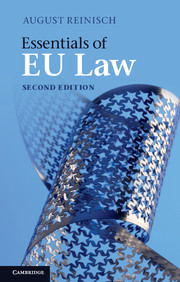Book contents
- Frontmatter
- Contents
- Preface
- Abbreviations
- 1 History of European integration
- 2 The institutional framework
- 3 The making of Union law
- 4 The effect of Union law
- 5 Judicial control within the Union
- 6 Protecting fundamental rights within the EU
- 7 The free movement of goods
- 8 The free movement of persons
- 9 EU competition law
- 10 Selected EU policies
- 11 The EU as an international actor
- Index
1 - History of European integration
Published online by Cambridge University Press: 05 November 2012
- Frontmatter
- Contents
- Preface
- Abbreviations
- 1 History of European integration
- 2 The institutional framework
- 3 The making of Union law
- 4 The effect of Union law
- 5 Judicial control within the Union
- 6 Protecting fundamental rights within the EU
- 7 The free movement of goods
- 8 The free movement of persons
- 9 EU competition law
- 10 Selected EU policies
- 11 The EU as an international actor
- Index
Summary
For centuries, the history of the small continent, or quasi-continent, of Europe has been a history of war and peace, where rival political entities, predominantly in the form of nation-states, have tried to dominate each other. The terrible twentieth-century experience of two World Wars, fought mainly on European territory, provided the necessary impetus to seek alternative ways of political survival, co-existence, or even cooperation. In its historic context, European integration must be understood as an attempt primarily motivated by the desire to secure peace and stability through establishing appropriate institutions. The institutions created in post-war Europe were based on ideas, partly dating back to the Middle Ages. However, it was the situation after 1945 which made it possible to think about actually setting up new structures which would make war in Europe, if not impossible, then at least much less likely. The creation of a European Coal and Steel Community (ECSC) in 1951, by which two strategically important industry sectors of rival nations like France and Germany were pooled, was such an important and highly pragmatic first step. It was soon followed by the establishment of two further organisations, the European Economic Community (EEC) and the European Atomic Energy Community (EURATOM) in 1957, which were designed as open regional organisations with a long-term goal of a yet undefined European unity.
Until today the process of European integration has been characterised by a constant tension between the maintenance of individual Member State power and further integration, leading to ‘an ever closer union among the peoples of Europe’, as promised in the opening lines of the 1957 Treaty of Rome’s preamble.
- Type
- Chapter
- Information
- Essentials of EU Law , pp. 1 - 14Publisher: Cambridge University PressPrint publication year: 2012



